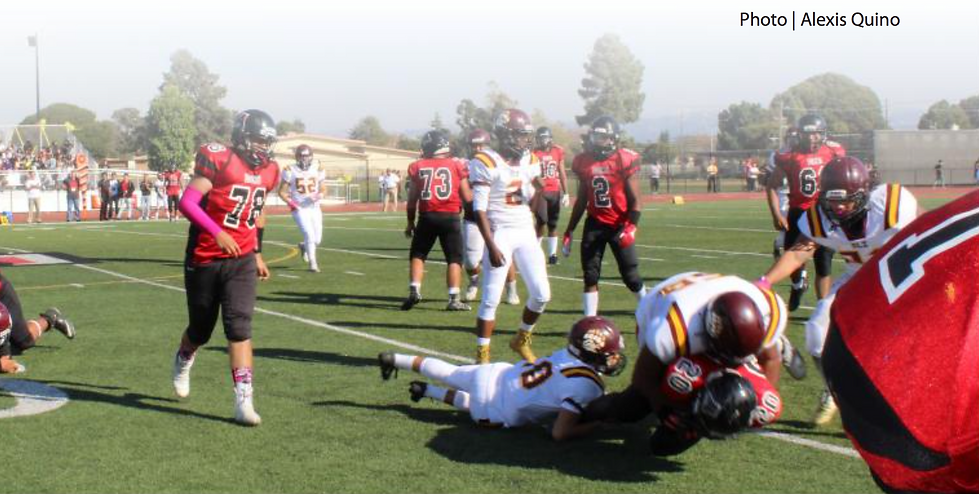
Dropping Players
Published on Feb. 26 2020
SPORTS
There are low numbers in football, and injuries might be the cause.
By Alexis Quino
Over the last 10 years, the participation rates in AHS football has been on a slow decline. In 2009, the varsity team had a roster of 34 players. five years later, they dropped to 27 players. Last year, the team went back up to 31, and this year, it dropped again to 22 players.
Field injuries are very common in high school football, and the AHS team is no exception to that. The Mercury News says that there’s been a 12.14% drop in participation since 2011 and as of 2018, there was a 3.16% drop. The nationwide decline is most likely due to the high risk of injuries.
As much as players love the game and people love to watch, there is no denying how dangerous football can be. According to the U.S. National Library of Medicine, knees are the most common site of injury with high school football players.
Senior Chris Michael Velasquez has been playing for AHS for two years, his freshman and senior year. Due to an ACL injury during a practice his junior year, Velasquez was unable to play for the rest of the season.
“I was doing a one-on-one drill and when I planted my foot sideways, my knee got stuck and rotated. The person I went against fell on top of me and I couldn’t get my leg out,” Velasquez said.
Another player who is no stranger to knee injuries is Junior Demarcus Smith. He’s been playing for AHS for two years, his sophomore year and this year. Smith’s recent injury had him out for 2-3 weeks.
“[S]omeone hit me the wrong way as I was going out of bounds,” Smith said.
When players get injured, there’s a certain "protocol" that needs to be followed in order to make sure the student athletes receive the proper care. Coach Mikal Dace and the rest of the coaching staff always try to err on the side of caution when it comes to injuries, especially concussions.
“Concussions are dealt with as they are reported or observed...we make the suggestion to the parents and at that point it’s the parents’ decisions to take the child to the hospital,” Dace said.
Concussions are the second most common injuries in football, composing 47.1% of football related trauma, as stated by the U.S. National Library of Medicine. Sophomore Giovanni Pantoja has played two years for AHS, and has already received two concussions this year, and four in his total years. The tell-tale sign of a concussion is amnesia, and Pantoja has experienced it first hand after getting hit last year.
“But apparently they were all saying I didn’t know my parent’s name, where I was, or what day it was so I had to go to the hospital.”
Despite the multiple concussions, Pantoja hasn’t really thought of quitting football.
“I like the experience. It’s fun to play, and you have a whole family with the team...” Pantoja said.
With an athletic trainer at the sidelines, the players receive quick medical attention if they’re injured. Lawrence Vanhook, AHS’ athletic trainer for football, has been in his field of work since 2014. In his five years of being an athletic trainer, he’s seen countless field injuries and at least 50 concussions.
“I’ve seen some pretty bloody things,” Vanhook said, “But the concussions are the most severe, at least in in terms of long term damage.”
The worst concussion he saw was about a year ago, when a kid got hit in the head and continued to play because he didn’t know he was concussed.
“[W]hen he came out, I saw he was a little bit dazed and he didn’t know what his name was. He didn’t know a lot of the basic information that he should’ve known, but it’s mainly because he didn’t come out and got hit again,” Vanhook said.
Even San Lorenzo High School’s Grizzlies have seen a little decline. 10 years ago, SLZ had 29 players. Last year, the roster increased to 37 players; this year, the numbers dropped to 25. Multiple high schools throughout California have seen a decline.
With a decreased interest in 11-player football, there’s been an increase of popularity in 8-player football across a few high schools in the states. Other school’s have adapted by merging their teams with another high school that also has low numbers in football. With our team dwindling in numbers, the football staff has to adapt.
“Those who are interested, are going to be interested,” Dace said. “As far as recruiting on campus, I promote it as more of a learning opportunity.”
Injuries aren’t the only components to the decline in participation, Dace believes the team’s performance is also an underlying factor.
“Winning doesn’t hurt...when we start winning, then we’ll have 90+ people coming out.”
Although football is a risky sport, there are precautions and protocols in place for the safety of the young athletes, as well as a coach that has safety concerns.
“I often try to reiterate to these student athletes that they have to use that body for the rest of their life,” Dace says, “And remind them that they’re only 14, 15, and 16.” •

Two SLZ players tackle an AHS player at the Helmet Game on Oct. 26.



